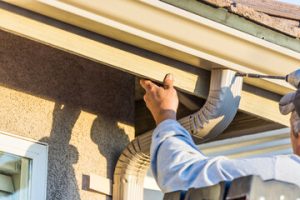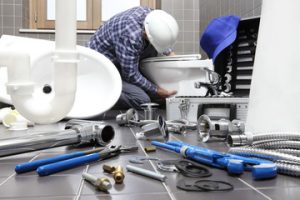Gutters help shed water, preventing soil erosion that harms landscaping and walkways. They also prevent foundation damage and costly repairs by diverting excess water away from the home’s foundation.

Professionals know how to assess a home’s gutter needs, considering factors like roof style and climate, for tailored, efficient gutter installation that safeguards a house for years. Contact Gutter Installation Gainesville FL for professional help.
Gutter installation is an investment that improves the longevity and efficiency of your home’s roofline. It’s important to understand the costs involved before hiring a professional gutter installation service. The cost depends on several factors, including the size of your home and the type of gutters you choose. Getting multiple quotes from different companies is essential to compare prices and make an informed decision.
First, measure your roofline to determine the total area of your roof that needs gutters. Accurate measurements are crucial to ensure the installation process is done correctly. This will also help you to plan for downspout extensions, which are vital in directing water flow away from your foundation.
In addition to the size of your roof, other factors that affect gutter installation costs are the type of gutters and their width. The most popular gutters are aluminum, vinyl, and steel. The cost of each material varies, but the most economical option is aluminum. However, this type of gutter is less durable and may corrode over time. Alternatively, you can opt for premium features such as seamless gutters, which are less prone to leaks and require less maintenance.
Lastly, you must consider the number of downspouts and their location. These are essential to ensure that the water flows from your roof in the right direction and does not overflow during heavy rains. Installing downspouts requires time and expertise, so they will add to the overall project cost.
Gutter installation can take anywhere from a few hours to a few days depending on the size of your home and its complexity. Intricate rooflines and the inclusion of additional features like gutter guards can significantly lengthen the timeline. Nevertheless, you should set realistic expectations and consult with a pro for an accurate timeline.
The average cost of gutter installation is around $4 to $5 per square foot, depending on the material and size you choose. Other factors that impact the price of gutter installation are labor rates and local service charges, as well as material prices and delivery fees. Additionally, the installation process is much more difficult for taller houses, so you can expect to pay more for specialized tools and expertise.
Timeline
Gutter installation can be a time-consuming process, especially when adding specialized features like gutter guards. These add-ons are designed to prevent clogging, which reduces the need for regular cleaning and maintenance. They also increase the lifespan of your gutter system, so they should be added as soon as possible. However, a variety of factors can affect the timeline for gutter installation. These include the size of your home, roof structure, and the condition of your existing gutters. External elements, such as weather conditions, can also delay the project. In these cases, it’s important to be flexible and communicate with your contractor about the expected timeline of the work.
The best times for gutter installation are spring and fall, when temperatures are moderate. This helps to minimize the risks of damage caused by heavy rains or melting snow. Additionally, homeowners can address any underlying issues during this period and ensure that their gutters are ready for the coming season. In addition, local building codes may require a certain gutter size and configuration to ensure proper water and snow drainage.
Experienced roofing professionals account for these variables when preparing estimates for gutter replacement projects. They also evaluate structural access points and any potential obstacles such as solar panels or landscaping. This allows them to establish practical anticipations for the duration of the job and avoid scheduling conflicts.
Choosing the right contractor is also essential for gutter repair timelines in 2025. This is because they can provide expert guidance on the best gutter type and style for your home. They can also help you comply with local codes and regulations by providing you with the proper permits needed for your gutters. In addition, they can recommend gutter accessories and solutions that improve performance and extend the life of your gutter system.
Lastly, homeowners should prepare for the gutter repair project by clearing the work area. It is recommended to move any outdoor furniture or plants that could be obstructed during the installation process, as well as power outlets that are located nearby. These steps will ensure a safe and efficient working environment for installers and can greatly reduce the overall length of the project.
Expertise
Gutters are an essential part of your home’s structural integrity and water drainage system. They protect against interior flooding and foundation damage. While gutter installation may seem like a simple project, it requires precision and expertise to ensure proper function. Choosing the right contractor can make all the difference. A professional gutter expert can assess your home’s needs and guide you through the process of selecting the perfect system. They will consider the local climate, roof style, and other factors to recommend the best solution. They can also help you choose the correct gutter size for optimal performance.
A professional gutter installer should have at least two years of hands-on experience in residential and commercial gutter systems. They should be proficient with hand and power tools, and able to work safely at heights. They should have a strong understanding of OSHA guidelines to promote safety and compliance with local codes. They should also be able to communicate effectively with clients and ensure timely project completion.
During a new gutter installation, a professional gutter contractor will start by assessing the current condition of the existing gutters. This will include examining the gutters for any signs of leaks or rot. They will also check the gutter downspouts to make sure that they are properly directing water away from the home’s foundation. If there is any damage to the existing gutters, it’s important to fix these problems before installing new ones.
While gutters are relatively easy to install, they can be difficult to replace or repair without the proper tools. Professional gutter installation services provide all of the tools necessary for the job, so you don’t have to worry about obtaining these yourself. In addition, professional gutter installation services can offer you a warranty on their work.
While DIY gutter projects can be cost-effective in the short term, they can lead to future costly repairs and replacements. In contrast, professional installation offers a more cost-effective solution in the long run. In addition to saving you time and money, professional gutter installation can also improve the appearance of your home and increase its value.
Safety
Gutters are an essential component of any home’s roofline, protecting it from water damage and preserving the integrity of the structure. However, gutter installation requires a certain level of technical proficiency and a rigorous commitment to safety protocols. Taking the necessary precautions can mitigate the risk of injury during the process and ensure that the gutter system functions properly over time.
Safety measures include choosing the right ladder for the job, ensuring that all tools and materials are within reach, and using personal protective equipment such as gloves, goggles, and a hard hat. It is also a good idea to take frequent breaks, especially in warm weather, to avoid heat exhaustion and fatigue. Additionally, it is a good idea to have a buddy system during the installation process, as it is not safe to work alone at heights.
Another important safety measure is to assess the worksite and identify potential hazards, such as uneven terrain or overhead electrical lines. These should be avoided, and the project should be scheduled for a day with clear, calm weather conditions to minimize risks of injury. Ladder safety is also crucial, and a sturdy ladder with a set of ladder stabilizers should be used.
During gutter installation, it is important to consider the slope of the roofline and ensure that the gutters are installed at the correct angle. This is critical to directing rainwater away from the foundation of your house, which can cause erosion and cracks in the foundation over time. A good guideline is to allow for a slope of 1/4 inch for every 10 feet of gutter length.
Once the gutters are installed, it is important to test them by running water through them to check that they are functioning correctly. It is also a good idea to schedule regular maintenance to ensure that the gutters are clean and free of obstructions.
Gutter installation is a complex task that should only be undertaken by professionals with the proper experience and training. Professional installers will ensure that the job is completed safely, and will deliver a functional gutter system that protects your home from water damage for years to come.







